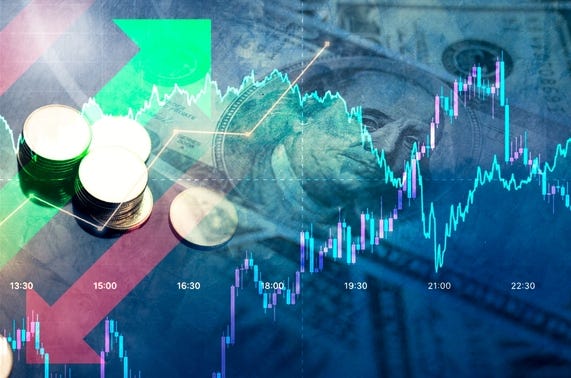ECONOMIC UPDATE: All That Glitters is Gold
The Trends Journal called gold's bottom earlier this year...Welcome to the end of U.S. interest rate hikes, the beginning of the diving dollar, and the rise of gold prices
NOTE TO READERS: The below article was found in this week’s Trends Journal. Please consider subscribing below for the world’s best trend-forecasting and independent news analysis.
As we had forecast since the U.S. Fed started raising interest rates back in March 2022, the higher interest rates rise, the stronger the dollar will get.
And the stronger the dollar gets, the deeper gold prices will fall.
And as Trends Journal subscribers well know, we called the bottom of gold prices last year when prices fell to around $1,750 per ounce, and this year when gold slumped below $1,850 per ounce.
We have also long forecast that when the U.S. Feds start lowering interest rates, and/or The Street believes the rate hikes have ended… the lower interest rates fall, the deeper the dollar will fall. And the deeper the dollar falls the higher gold prices will rise.
Welcome to the end of U.S. interest rate hikes, the beginning of the diving dollar, and the rise of gold prices.
Today, the yield on the 10-year U.S. Treasury that hit nearly 5 percent last month is trading at 4.4 percent, the U.S. dollar is at a three-and-a-half-month low, and gold prices are trading at $2,042 per ounce as we go to press.
We forecast that December will not be a Merry Christmas for stock markets and the retail sector.
Repeating what we had long forecast, in a note published by Goldman Sachs over the weekend titled, “Gold’s shine is returning,” the bank sees gold prices going higher this year and next.
“The potential upside in gold prices will be closely tied to U.S. real rates and dollar moves, but we also expect persistent strong consumer demand from China and India, alongside central bank buying to offset downward pressures from upside growth surprises and rate cut repricing.”
FOLLOW GERALD CELENTE ON YOUTUBE
Indeed, since gold, as with many commodities, is dollar-based, the lower the dollar falls the cheaper it will be for other nations to buy gold as the value of their currencies rise.
There is also continuing concern, as we detailed in previous Trends Journals, for an increasing desire for safe-haven assets—of which gold shines the brightest—as the geopolitical and socio economic climate disintegrates for all those with an open mind to see.
We also forecast that the higher gold prices rise, so too will silver, which is trading at $25 per ounce as we go to press.
Bright Black Friday?
In America—where manufacturing accounts for just 11 percent of the nation’s Gross Domestic Product (GDP) as a result of NAFTA, bringing China into the World Trade Organization and the relaxation of trade barriers that politicians who get paid off by the corporate barons inflicted upon the nation—consumer spending, which accounts for almost 70 percent of the nation’s GDP is what keeps the equity markets and the economy on its high.
CNBC’s big headline today is Black Friday weekend shopping turnout soars to a record, as consumers seek bargains
Shoppers kicked off the holiday season with a bang, as a record 200.4 million people hit stores and searched websites for gifts from Thanksgiving Day through Cyber Monday, according to a survey by the National Retail Federation.
The turnout marks an all-time high since the major trade group and Prosper Insights & Analytics began tracking total in-store and online traffic in 2017. It topped last year’s figure of 196.7 million shoppers and the NRF’s forecast for about 182 million people during the five-day weekend.
The number of people shopping online rose to 134.2 million this year, up from 130.2 million a year ago, the NRF survey found. Consumers who shopped at stores fell slightly, from 122.7 million people in 2022 to 121.4 million people this year.
The major trade group did not estimate total spending, but said shoppers shelled out an average of $321.41 on holiday-related purchases over the weekend. That’s roughly in line with the $325.44 average last year. The number is not adjusted for inflation.
So in essence, while more people went shopping, when accounting for inflation, which these numbers have not been adjusted for, the numbers are down from last year. The bottom line is that because of real inflation, more people spend more to buy less.
TREND FORECAST: The less money consumers spend during the holiday season, the deeper the equity markets will fall. Therefore, we forecast that December will not be a Merry Christmas for stock markets and the retail sector.
Lower Inflation?
And as for inflation making it costing more to buy less, more bad news for the plantation workers of Slavelandia; even as mortgage rates climbed to about 8 percent, home prices keep rising.
According to the S&P CoreLogic Case-Shiller US National Home Price Index home prices climbed 0.7 percent in September from August.
Compared to a year ago, the national composite index also rose, with prices up 3.9 percent from September 2022, the data shows.
Craig Lazzara, managing director at S&P Dow Jones Indices, noted that “Although this year’s increase in mortgage rates has surely suppressed the quantity of homes sold, the relative shortage of inventory for sale has been a solid support for prices.”
TREND FORECAST: Since the Fed started to raise interest rates, most of The Street had forecast that there would be a sharp housing market selloff. Ignoring our forecast that housing prices would stay high, back in 30 August 2022, Reuters headline said the opposite. U.S. house price inflation to plunge in 2023, fair value still a distant dream.
They went on to quote Scott Anderson, chief economist at Bank of the West who had forecast that “Home price appreciation is set to come to a screeching halt under the weight of poor housing affordability and a deteriorating economic and financial environment.”
Facts and Fiction
The housing boom that accelerated when the Fed lowered interest rates to near zero and the 30-year fixed rate hit an all-time low of 2.65 percent in January 2021, was different from the Panic of ’08 housing bust which we had also forecast. Indeed, we took out the Panic of 08 domain name in November 2007.
Back then it was the subprime mortgage fiasco in which banks loaned money to people with toilet grade credit ratings that artificially propped up the housing market.
This time—beginning in 2020 and still going strong—people who could afford to buy homes but were afraid of dying from the coronavirus fled out of big cities to safer-haven suburbs and ex-burbs. That trend continues as the remote work-at-home trend that accelerated during the COVID War as employees were told not to come to the office in fear of dying from the virus… has become the new normal.
Therefore, minus a major financial crisis, which is possible when the Office Building Bust brings down much of the banking system, residential home prices will stay high even when interest rates fall and there is more housing supply than demand.
Besides the Office Building Bust that was a result of the COVID WAR, the implications of vacant buildings, low office occupancy rates, rising crime, homelessness, and a migrant crisis are making downtowns not the place to be.




